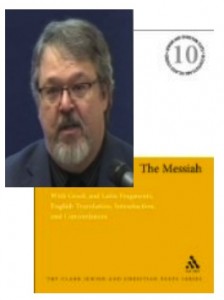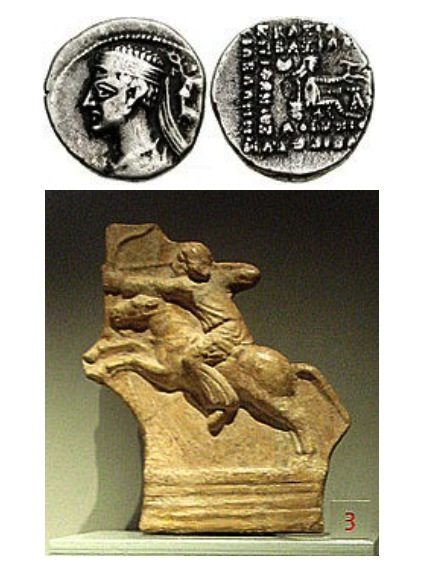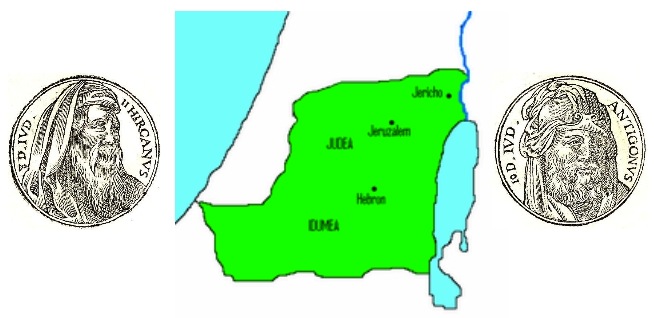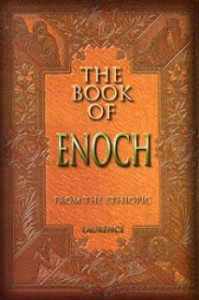
The Christ we read about in the letters of the Apostle Paul has many striking similarities to another Christ we read about in the earlier Second Temple Jewish Book of the Parables of Enoch. So much so that James A. Waddell, Philip Markowicz Visiting Professor of Jewish Biblical Studies at the University of Toledo, argues in The Messiah: A Comparative Study of the Enochic Son of Man and the Pauline Kyrios that Paul belonged to that stream of Jewish intellectual tradition that developed its concept of Christ, the Messiah, out of the messiah traditions we read about in the Book of Enoch.
(The Book of Parables is also known as the Similitudes of Enoch. In this post I will follow Waddell and use BP to refer to this text.)
Too late?
Some readers will immediately ask if the Enochic Book of Parables is too late. Is it not from a post-Gospel era? Waddell informs those of us who still think this that we are out of date:
Only recently has specific research on the date of BP created a shift in the scholarly consensus among specialists of the Enoch literature. This consensus established the messiah traditions of BP, if not the text itself, to a date prior to Paul. (p. 22 of The Messiah)
Waddell’s book was published in 2010 and his claim about the scholarly consensus is supported by reference to half a dozen articles in Boccaccini’s Enoch and the Messiah Son of Man (2008) among a list of earlier publications.
To me, and I am sure to many others, questions of dating are important. So this post attempts primarily to explain Waddell’s rationale (presumably shared by many of his peers) for dating the BP to a pre-Christian era. The next post will begin to examine the nature of the Christ/Messiah as understood before Paul among the Jews associated with this document.
|
Maurice Casey’s ‘Son of Man’ arguments Other readers may wonder about the stress upon the “Son of Man” in both the above titles given that (1) Paul never uses the “Son of Man” in relation to Christ, and (2) Emeritus Professor Maurice Casey is reputed to have written “the definitive” work on the Son of Man and supposedly buries any notion that “son of man” was employed as a messianic title up to and including the time of Jesus. As for (1), Waddell’s thesis includes a cogent theological explanation why Paul would have shunned the term in relation to his Christ; as for (2), Waddell exposes inconsistencies in Casey’s treatment of the evidence and generally leaves Casey’s approach to the question looking tendentious indeed. |
|
Larry Hurtado’s ‘worship’ arguments Another contemporary Emeritus Professor addressed by Waddell is Larry Hurtado. Waddell agrees with Hurtado’s case that the evidence argues that the Christ Jesus was worshiped “from the moment of the Easter experience” (jargon designed to harmonize the Gospel-Acts narrative with modern rationalist sensibilities) for the beginning of Christianity, but rejects Hurtado’s complementary claim that the worship of any other figure apart from God himself was unknown among Jews before Christianity. Waddell argues that evidence contradicting a scholar’s personal faith has been treated tendentiously. The BP do indeed depict early Jewish worship of a being alongside God. |
.
The Date of the Parables of Enoch
One of the reasons many scholars have long thought the Parables of Enoch post-date the Gospels is the failure to find this text among others from the Book of Enoch in the Qumran caves. Other sections of 1 Enoch were found there, but not the Parables. The Parables must have been composed after the demise of the Qumran community, so the argument goes.
Waddell informs us, however, that
at this point in the state of the research the best tool we have for dating BP is historical allusion. (p. 23)
A number of historical allusions have been identified in the BP.
[table “” not found /]
This event of 40 B.C.E. is worth noting in some detail.
The Parthian forces invaded Judea from the north intending to overthrow the ruling high priest, Hyrcanus II, and to install the last scion of the Hasmonean ruling party, Antigonus, nephew of Hyrcanus.
When the high priest Hyrcanus fell at the feet of Antigonus, Antigonus “bit off his ears” in order to permanently disqualify him from the priesthood then exiled him to Babylon. (The Jewish Virtual Library says he was castrated. Were “ears” a euphemism?)
So at a time of Parthian plundering of Judea and capture of Jerusalem, the High Priest of the Jerusalem Temple was violently assaulted and deposed.

Compare an earlier passage in BP. 1 Enoch 46:4-5 appears to depict the cosmic judgment that is soon to follow the events of 40 B.C.E.:
4, And this Son of Man whom thou hast seen
Shall †raise up† the kings and the mighty from their seats,
[And the strong from their thrones]And shall loosen the reins of the strong,
And break the teeth of the sinners.5. [And he shall put down the kings from their thrones and kingdoms]
Because they do not extol and praise Him,
Nor humbly acknowledge whence the kingdom was bestowed upon them.
Waddell notes the similarity of the expressions used here and those in 1 Enoch 56:5 (see also the table above):
They shall stir up the kings, so that a spirit of unrest shall come upon them,
And they shall rouse them from their thrones
The difference is that in Enoch 46 the Son of Man is delivering judgment upon them.
1 Enoch 46:7-8
7. And these are they who †judge† the stars of heaven,
[And raise their hands against the Most High],
And tread upon the earth and dwell upon it.And all their deeds manifest unrighteousness,
And their power rests upon their riches,
And their faith is in the †gods† which they have made with their hands,
And they deny the name of the Lord of Spirits,8. And they persecute the houses of His congregations,
And the faithful who hang upon the name of the Lord of Spirits.
- “Judging” or “discerning” the stars of heaven may allude to some form of Babylonian astrology.
- Raising their hands against the Most High may refer to the Parthian conquest and plunder of the Temple and the violent overthrow of the High Priest in 40 B.C.E.
- The persecution of the people may point to the Parthian plundering of Judea and the Temple.
Waddell finds “especially appealing” the possibility that the second point, “raising their hands against the Most High”, is explained by the violence against and overthrow of the High Priest John Hyrcanus, given that the BP contains no hint of anti-priestly or anti-temple polemics. The BP has not been found among the Qumran scrolls, and the Qumran community is well-known for its hostile attitude towards the Temple of this Second Temple era.
It is entirely possible that the community responsible for producing BP was in some way a part of the mainstream Essene movement that retained some contact with the Jerusalem temple. If this is the case, then it is not in any sense a stretch of the imagination that the author(s) of BP might have considered an attack on the high priest in some sense an attack on the Most High. (p. 27, The Messiah)
If BP does indeed refer to the events between 53 and 40 B.C.E. then we may reasonably conclude that they were relatively recent from the author’s perspective. (I note that 1 Enoch 46 would anticipate an imminent eschatological judgment upon the marauding Parthians and the new tyrannical ruler, Antigonus, they installed in power.)
This would further suggest a date for BP much closer to sometime within the latter half of the first century B.C.E. after the Parthian invasion of 40. (p. 27, The Messiah)
If this section of the First Book of Enoch is best dated to within the final decades of the first century before the turn of the era, then the implications for prevailing Jewish messianic ideas extant at the time Christianity was emerging are (I think) enormous.
This is not, per se, a mythicist argument. Don’t misunderstand. I am quite sure James Waddell would be bemused if he thought his arguments were used for any such end. There are, after all, some distinctive differences between Paul’s Christ and the Christ found in the Parables. Paul’s Christ was crucified and resurrected. He did not refer to him as the Son of Man. But the Enochic literature — and other scholars have certainly noted this, in particular Margaret Barker — nonetheless has major implications for the origin of a good number of Christian beliefs. The first task is to examine some of the similarities. After that we can ask other questions to help us towards the most likely explanation for those similarities.
If you enjoyed this post, please consider donating to Vridar. Thanks!


From Wiki on BP:
“Presumed by western scholars to be written during 1st century BC or very beginning of 1st century AD.[68]
No fragments of chapters 37–71 (Book of Parables) were found at Qumran. This led J.T. Milik in 1976,[38] in line with many scholars of the 19th century as Lucke (1832), Hofman (1852), Wiesse (1856) and Phillippe (1868), to believe that those chapters were written in later Christian times by a Jewish Christian to enhance Christian beliefs with Enoch’s authoritative name.
However, J.H. Charlesworth summarized[69] the current scholarly consensus, saying: “It became obvious that Milik had not proved his position, as Fitzmyer pointed out as soon as The Book of Enoch had been published. Repeatedly the specialists on I Enoch have come out in favor of the Jewish nature and its first century CE origin, and probable pre-70 date. The list of specialists on I Enoch arguing for this position has become overwhelmingly impressive: Isaac, Nickelsburg, Stone, Knibb, Anderson, Black, VanderKam, Greenfield and Sutter. The consensus communis is unparalleled in almost any other area of research; no specialists now argue that I Enoch 37-71 is a Christian and postdates the first century.” .
Charlesworth’s words were published in 1985 and Waddell lists him as one of those who has been instrumental in contributing to the consensus among specialists in Enoch studies today.
Some of the reasons for the BCE dating have changed in their details, if I understand Waddell correctly. The outline of historical events against passages in BP are apparently different in some ways from earlier attempts to identify historical allusions. For example, 56:5 had been linked with the Parthian invasion of 40 BCE, whereas Waddell (presumably with support of others) sees in chapters 56 and 57 two distinct events and periods: 56:5 pointing to 53 BCE and 57:1 to 40 BCE.
The names he cites from the Boccaccini volume:
David Suter
Michael Stone
James Charlesworth
Darrell Hannah
Luca Arcari
Hanan Eshel
Names associated with earlier attempts to date the BP with variable results:
R.H. Charles
Jonas Greenfield and Michael Stone (1977)
J.C. Hindley (1968)
Michael Knibb (1978-79)
Christopher Mearns (1978-79)
So it appears the view of BP dating to around the late first century BCE has only strengthened since 1985.